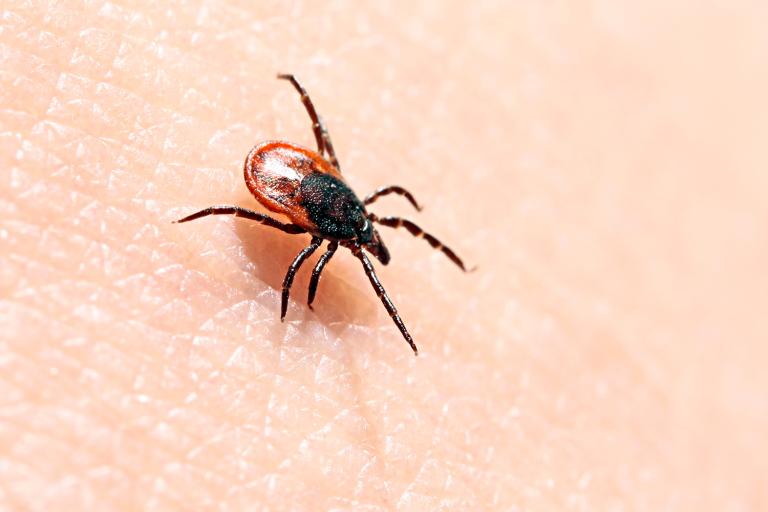If you are exhausted, have joint or muscle pain, memory issues, and headaches, and/or suffer from an “atypical” condition—you might have Lyme disease, a master of disguises.
Countless patients see me after years of illness without an accurate diagnosis. Once we reach a Lyme disease diagnosis, they begin to get their life back.
Symptoms of Lyme Disease
In the 1970s, some children in Lyme, CT, developed symptoms of juvenile rheumatoid arthritis. Researchers discovered that black-legged ticks carrying Borrelia burgdorferi bacteria had bitten the children, causing what came to be known as Lyme disease.
-
Early Symptoms
Early on, Lyme disease resembles the flu, with signs and symptoms that can include:
- Rash (erythema migrans)
- Headaches
- Sore throat
- Chills
- Fever
- Fatigue
- Stiff neck
- Swollen lymph nodes (lymphadenopathy)
-
Late Stage Symptoms
If incorrectly diagnosed and treated, Lyme-disease-causing bacteria affect other body systems with signs and symptoms including:
- Chronic fatigue
- Muscle aches
- Joint pain and/or swelling
- Neurological issues
- Paresthesias (pins-and-needle sensations, burning, itching
- Memory issues
- Lightheadedness
- Fainting
- Pain that disrupts sleep
- Gastrointestinal upset
- Chest pain or palpitations
- Headaches
- Visual disturbances
- Light/sound sensitivity
- Anxiety
- Depression
Lyme Disease Diagnosis
An accurate diagnosis challenges doctors because patients can have Lyme disease along with multiple sclerosis, ALS, fibromyalgia, chronic fatigue syndrome, depression, heart problems, arthritis, neurological disease, and more.
-
Diagnosis Challenges
When diagnosing Lyme disease, most doctors look for the “bulls-eye rash”—called the erythema migrans (EM) rash, with concentric rings surrounding a red center—but only 70 to 80 percent of patients develop it.
An EM rash or multiple EM rashes can appear up to 30 days after a tick bite, but most commonly at seven days. This warm-to-touch rash grows up to 12 inches and is usually not painful or itchy.
Even when there is a rash, some doctors don’t suspect Lyme. I have heard from patients with tick bites told by their doctor, “Lyme disease does not exist in California,” for example. Left untreated, they developed an unexplained chronic illness.
-
Testing Process
A Lyme diagnosis should not entirely rely on lab testing. Available testing methods have high false-negative and low sensitivity rates, as Lyme bacteria evade the immune system and are immunosuppressive.
The CDC recommends a two-step testing process. The first test, an ELISA test, looks for antibodies against Lyme. If positive, a Western Blot test is run, looking for IgM and IgG antibodies against antigens associated with Borrelia burgdorferi.
-
Lyme-Literate Medical Professionals
If you have symptoms, live in an endemic area, and recall a tick bite, yet have negative results, I recommend seeing a Lyme-literate doctor, found through the International Lyme and Associated Diseases Society (ILADS).
They are trained to recognize, test, and rule in or out Lyme disease and co-infections like anaplasma, ehrlichia, babesia, or bartonella.
A Lyme-literate doctor combines conventional and natural medicine. Integrative medicines support damaged tissue, help modulate the immune system, and maximize detoxification pathways for more effective healing.
Treating Chronic Lyme Disease
Chronic Lyme disease treatment includes:
- Long-term antibiotics
- Herbal medicines
- IV therapies
- Counseling
- Immune supportive therapies
- Diet changes
- Lifestyle modifications such as stress reduction and meditation
Antibiotics are effective in early stages, taking two to six weeks of treatment. For chronic Lyme disease, or post-treatment Lyme disease syndrome, where symptoms have been chronically or intermittently present for six months or more, treatment can take six months to two years or more.
Healing After Lyme Disease
Many patients experience a “two-step forward, one-step backward” progression: some symptoms improve, while others worsen or new ones appear.
Some may develop a Herxheimer reaction, a “die-off” of the Lyme organism causing inflammation. With treatment modifications, the reaction reduces and symptoms improve.
Lyme disease causes psycho-emotional, social, financial, and physical stress, so support from family, friends, and community helps patients persevere. My Lyme patients teach me most about perseverance, courage, and trust through this journey.
Lyme is a very insidious and poorly understood illness that we as doctors are still learning about on a daily basis.

